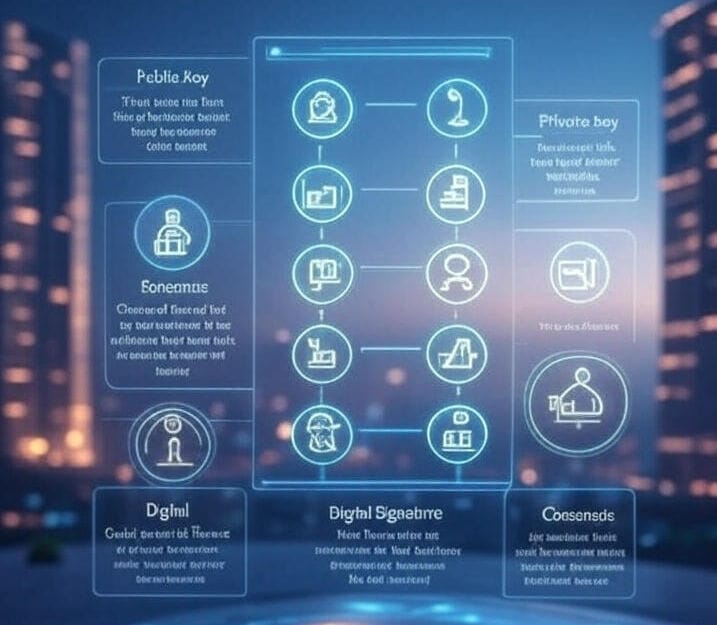Unlocking Trust in a Trust-less World: How Blockchain Uses Cryptography for Secure Transactions
Imagine trying to share a single, constantly updated notebook with a group of complete strangers – people you've never met and certainly don't trust. How do you make sure that when someone writes something down, it's genuinely them who wrote it, and not someone else trying to scribble over their entry or pretend to be them? This isn't an easy feat, but it's precisely the fascinating problem that blockchain technology aims to solve.
At its heart, blockchain isn't just about a fancy database; it's about enabling a network of strangers to use the same public record without needing a central authority or mutual trust. Unlike your bank, which handles your transactions privately, a blockchain is entirely public – meaning everyone on the network must be able to look at a transaction and be absolutely certain it's valid.
Think about it: if someone simply writes "Alice gives 50,000 coins to Bob," how can everyone else know that Alice really agreed to that, and it wasn't just Bob adding it himself? A simple password system wouldn't work in this public, decentralized environment. You'd either need a central body checking passwords (which defeats the point of decentralization) or Alice would have to shout her password to the world every time she made a transaction, allowing anyone to impersonate her after the first go.
This is where the magic of cryptography steps in – essentially, the art of transforming data for secure communication. While simple codes (like the Vigenère cipher, which uses the same key to encrypt and decrypt) allow you to hide a message, they have a flaw for our purpose: if you give someone the key to read your message, they can also use it to send messages pretending to be you. This is known as symmetric encryption, where the same key does both jobs.
The real breakthrough for blockchain is public key cryptography. This clever system uses a pair of mathematically linked keys:
- Your private key: This is your secret. Think of it as your digital identity or a powerful, unshareable password. You use it to digitally sign messages or transactions, proving they came from you. It's absolutely crucial that you never, ever share your private key, because anyone who gets hold of it can produce a valid signature to spend your money or completely impersonate you.
- Your public key: This is the key you can freely share with anyone. It's like your public identity tag. The clever part is that while your private key can easily generate your public key, it's virtually impossible to reverse-engineer your public key to get your private key. So, sharing it carries no security risk; in fact, you have to share it for others to verify your transactions.
So, how does this all play out in a transaction? When Alice wants to pay Bob, she creates a message saying, "I, Alice, pay 50,000 coins to Bob, and here is my signature to prove I authorized this transaction". She then uses her private key to digitally sign this message.
This signed message then travels across the peer-to-peer network. As it goes around, other users on the network can easily verify the transaction's authenticity by comparing Alice's public key with the signature. This process confirms that only the true owner of Alice's private key could have authorized that action. If the signature doesn't match, the transaction is simply ignored and won't be validated. This brilliantly stops unauthorized spending.
However, while public key cryptography solves the crucial problem of verifying individual transactions and preventing impersonation, it doesn't answer all the big questions for a distributed public database. For instance, we still need to figure out:
- How do we stop Alice from spending the same funds twice?
- How do we decide which transactions actually get included in the blockchain?
- Who makes these decisions, and how do we reach a consensus in a system where no one trusts anyone else?
These fascinating challenges are addressed by other ingenious mechanisms within blockchain technology, setting the stage for further exploration into how truly trust-less systems are built.
Conclusion
In conclusion, blockchain technology innovatively tackles the challenge of enabling a network of strangers to use the same public database without needing a central authority or mutual trust. Unlike traditional centralized systems where transactions can be validated privately, a blockchain requires every participant to be able to verify a transaction with certainty.
To achieve this, blockchain networks heavily rely on cryptography, specifically public key cryptography. This system uses a pair of mathematically linked keys: a private key and a public key.
- The private key is kept secret and acts as your identity or a password, used to digitally sign messages or transactions. It is crucial never to share your private key, as anyone who knows it can produce a valid signature to spend your funds or impersonate you.
- The public key can be freely shared, as it is virtually impossible to reverse-engineer it to obtain the private key.
When a transaction occurs, such as "Alice pays 50,000 coins to Bob," Alice digitally signs this message using her private key. This signed message is then passed around the peer-to-peer network. Users on the network can verify the transaction's authenticity by comparing Alice's public key with the signature, ensuring that only the owner of the private key could have authorized the action. If the signature doesn't match, the transaction is ignored and not validated, effectively preventing unauthorized spending.
While public key cryptography successfully addresses the issue of validating individual transactions and preventing impersonation, key questions remain for blockchain systems. These include how to prevent a user from spending the same funds twice and, more broadly, how to achieve consensus on which transactions to include in the blockchain within a distributed system.

